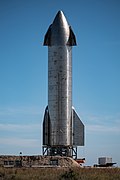| Revision as of 23:29, 16 October 2021 edit4throck (talk | contribs)Extended confirmed users18,187 editsNo edit summaryTag: 2017 wikitext editor← Previous edit | Revision as of 23:30, 16 October 2021 edit undo4throck (talk | contribs)Extended confirmed users18,187 editsNo edit summaryTag: 2017 wikitext editorNext edit → | ||
| Line 25: | Line 25: | ||
| | ]|| ] || ] (Artemis, 2017–present), SpaceX || 4 || 100–200 t (220,000–440,000 lb) || {{Planned}} || ] | | ]|| ] || ] (Artemis, 2017–present), SpaceX || 4 || 100–200 t (220,000–440,000 lb) || {{Planned}} || ] | ||
| |- | |- | ||
| | ]<ref>http://www.astronautix.com/b/bislunarlander.html</ref> || || British Interplanetary Society || 3 || Payload Mass || Study (1939, 1947) || | | ]<ref>http://www.astronautix.com/b/bislunarlander.html</ref> || || ] || 3 || Payload Mass || Study (1939, 1947) || | ||
| |- | |- | ||
| | ]<ref>http://www.astronautix.com/v/vonbraunlunarlander.html</ref>|| || US (1977) || 20 || 259 metric tons (with a crew of 10) || Study (1952) || | | ]<ref>http://www.astronautix.com/v/vonbraunlunarlander.html</ref>|| || US (1977) || 20 || 259 metric tons (with a crew of 10) || Study (1952) || | ||
| |- | |- | ||
| | ]<ref>http://www.astronautix.com/l/lunexlunarlander.html</ref>|| || US Air Force (Lunex Project, 1967) || 3 || 20,500 kg || Study (1958-1961) || ] | | ]<ref>http://www.astronautix.com/l/lunexlunarlander.html</ref>|| || ] (], 1967) || 3 || 20,500 kg || Study (1958-1961) || ] | ||
| |} | |} | ||
Revision as of 23:30, 16 October 2021
Misplaced Pages list article| This list is incomplete; you can help by adding missing items. (July 2020) |
This is a list of designs for crewed lunar landers, that is to say a spacecraft intended to land on the Moon, and for inclusiveness the designs meant to ascend are included also. A key aspect is achieving a soft landing, and for an ascent stage to successfully escape the Moon's surface gravity. Another aspect is how many stages the design has to achieve its objective, and the number of passengers and amount of payload it can haul.
| Name | Manufacturer | Operator (program and operational timeline) | Crew | Payload Mass | Status | Image |
|---|---|---|---|---|---|---|
| Altair | Northrop Grumman | NASA (Constellation, 2005-2009) | 4 | 14,500 kg (32,000 lb) | Canceled | 
|
| Apollo Lunar Module | Grumman | NASA (Apollo, 1969–1972) | 2 | Retired | 
| |
| Boeing Lunar Lander | Boeing | Boeing, NASA (Artemis, 2017–present) | Rejected | 
| ||
| Dynetics HLS | Dynetics | Dynetics, NASA (Artemis, 2017–present) | 2-4 | Rejected | ||
| Integrated Lander Vehicle | Blue Origin, Lockheed Martin, Northrop Grumman, Draper Laboratory | Blue Origin, Lockheed Martin, Northrop Grumman, Draper Laboratory, NASA | 2 | Rejected | ||
| LK | RSC Energia/Yuzhnoye Design Office | Soviet Union (N1-L3, 1969-1974) | 1 | Canceled | 
| |
| Lockheed Martin Lunar Lander | Lockheed Martin | Lockheed Martin, NASA (Artemis, 2017–present) | 4 | 1,000 kg (2,200 lb) | Proposed | |
| Starship | SpaceX | SpaceX | Planned | 
| ||
| Starship HLS | SpaceX | NASA (Artemis, 2017–present), SpaceX | 4 | 100–200 t (220,000–440,000 lb) | Planned | File:Starship HLS Moon landing.jpg |
| BIS Lunar Lander | British Interplanetary Society | 3 | Payload Mass | Study (1939, 1947) | ||
| Von Braun Lunar Lander | US (1977) | 20 | 259 metric tons (with a crew of 10) | Study (1952) | ||
| Lunex Lunar Lander | US Air Force (Lunex Project, 1967) | 3 | 20,500 kg | Study (1958-1961) | 
|
See also
- Human spaceflight – Spaceflight with a crew or passengers
- Lunar module – Lunar lander designed for human spaceflight
References
- ^ "NASA studying three-stage approach to human-class lunar landers". SpaceNews.com. 2018-11-20. Retrieved 2019-11-08.
- http://www.astronautix.com/b/bislunarlander.html
- http://www.astronautix.com/v/vonbraunlunarlander.html
- http://www.astronautix.com/l/lunexlunarlander.html